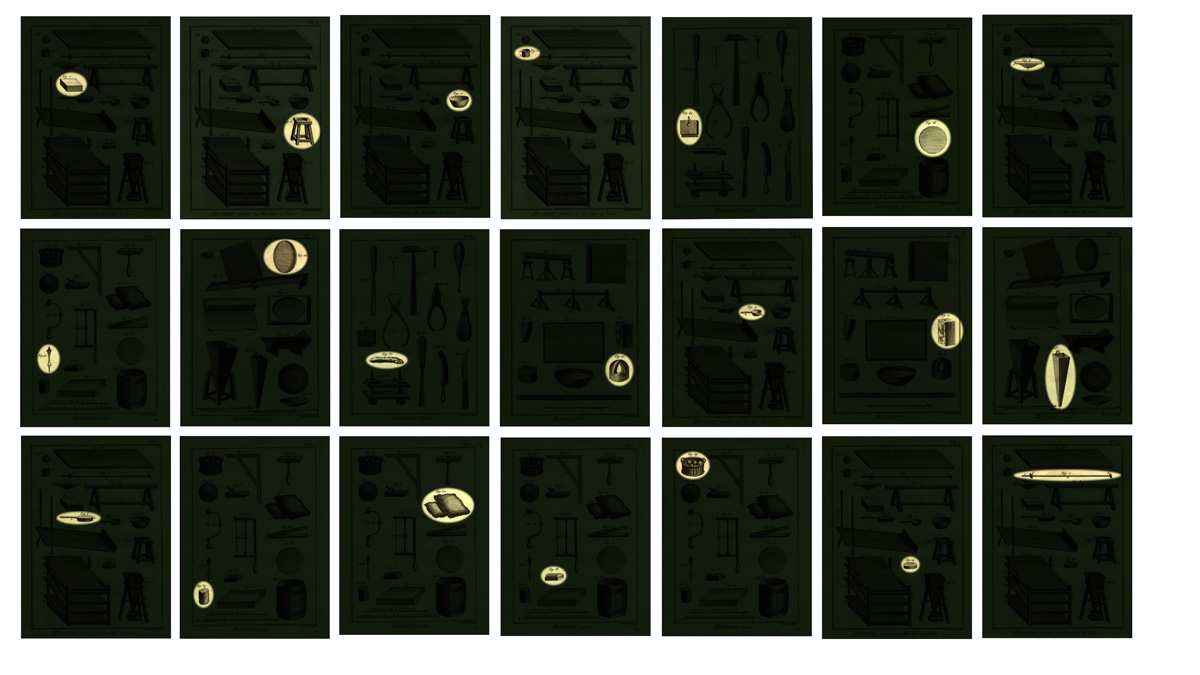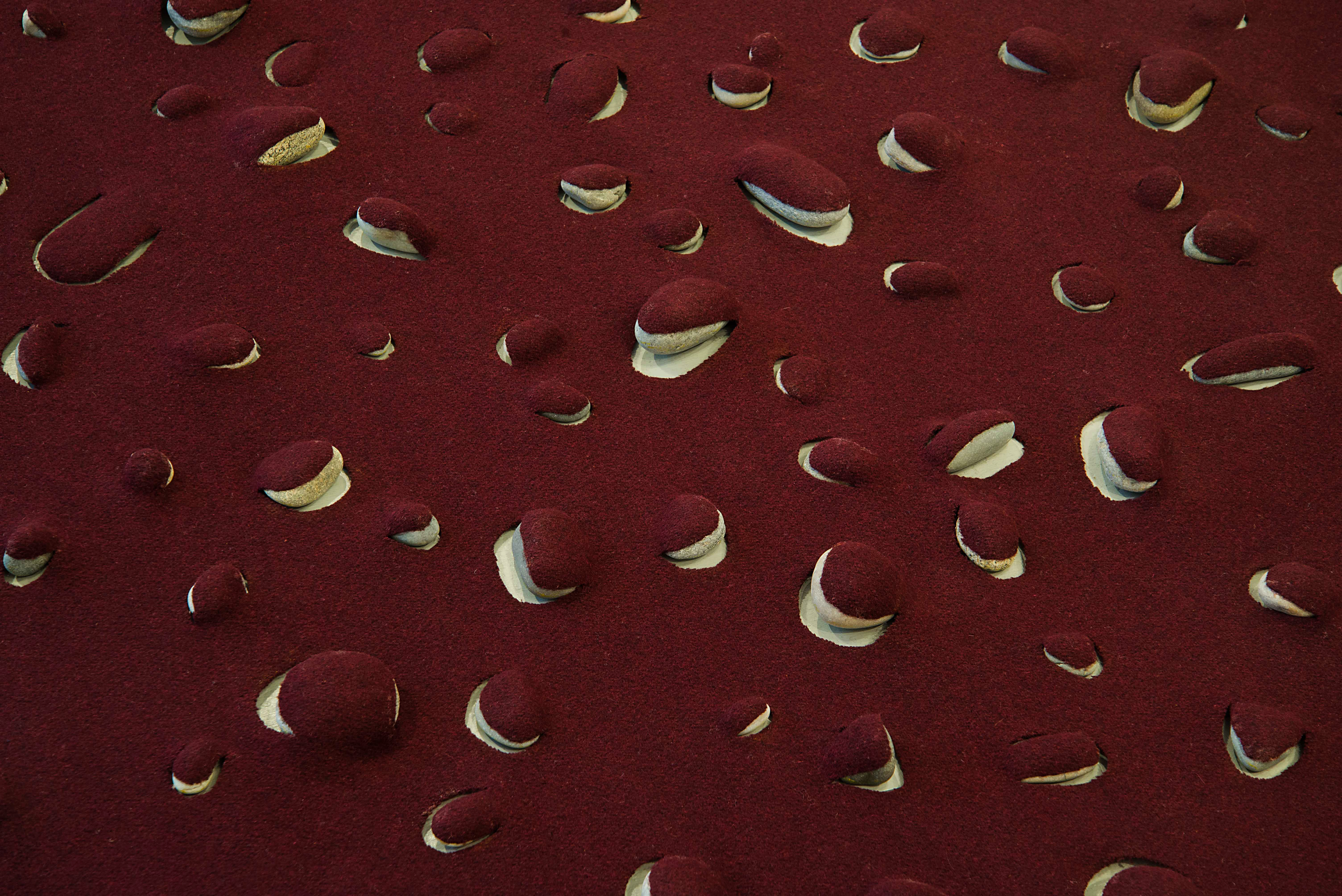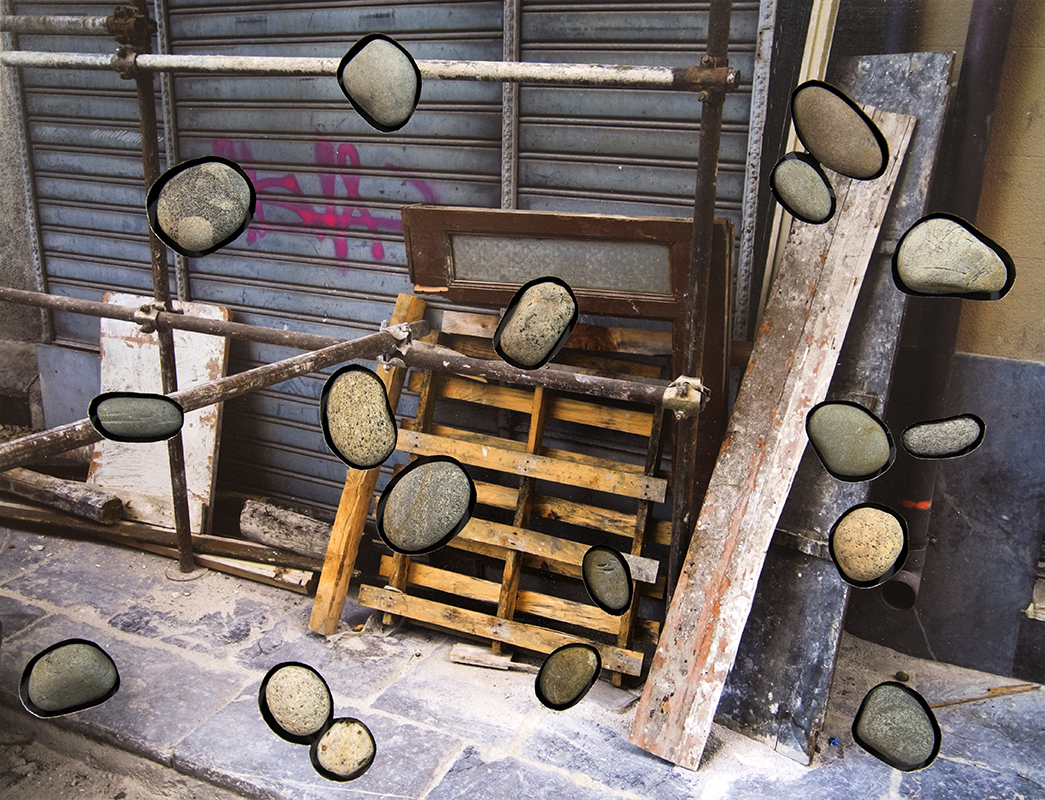1998
wood, steel, lead, felt, cloth, stone, glass, bamboo, raccoon, plaster, etc.
Variable dimensions, approx. 7’x25’x15
This project is based on the engraved plates of Diderot’s 18th-century Encyclopedia. The project entails an attempt to literally resuscitate the objects depicted in the engravings associated with the trade of mirror making. I constructed each object based solely on information in the engravings, requiring a unique act of interpretation because the engravings’ hatch and crosshatch line do not specify materiality, scale, form, or function.
The Encyclopedia engravings were originally made to illustrate the manufacturing processes of the time — the means by which the natural world was transformed by human hand for commercial use — to preserve the knowledge of the trades for posterity. In order to explain the methods, the manufacturing processes were dissected and presented as a visual inventory of discrete components, the materials and tools of the trade. The engravings depict the components out of context, forming peculiar juxtapositions between unfamiliar objects. Hence, despite the original intention to explain, the engravings to our eyes more likely evoke. The images are wide open for interpretation and, in that sense, encourage misinterpretation. The gap in time renders the images indecipherable to us as information; conditioned by a century of Modernism, we react to these images as occasions for imagination. I am interested in how this central document of the Enlightenment carries covert vestiges of irrationality, paralleling our contemporary ambivalence regarding scientific versus anecdotal, intuitive, or spiritual versions of knowledge.
By resurrecting the objects I complete a trajectory launching from the specific 18th century objects in use, proceeding to their generic representation as engraved illustrations, and finally returning to actualization as specific objects, but with a difference — as generic objects that have, of necessity, been specified through my attempt to render the engraver’s depiction. Each object I make thus occupies a position midway between historical resurrection and personal invention, between representation and concrete object unto itself. Paralleling my process in making the objects, photo-images from digital-scans inform the viewer of the objects’ relationship to the Diderot engravings. Each object from the inventory is isolated as a vignette by layering a nearly opaque cover over the rest of the imagery — as if a spotlight were illuminating an object on a stage while all else remains in shadow.
Catalog Texts about from L’Encyclopedie: Miroitier
Resuscitation of Ritual
by David Weisberg
Jeffrey Schiff’s “from L’Encyclopedie: Miroitier” returns rationality to its elemental form — ritual.
Using as his only guide the engraved illustrations found under the heading “Miroitier” (mirror maker) in Diderot’s monument of the Enlightenment, L’Encyclopedie, Schiff set about constructing in three dimensions tools and instruments the specific use of which he could barely surmise. His information was restricted to two domains: a principle of relatedness (all the objects belonged to a particular “métier”) and an historical marker, the mid-eighteenth century. The materials, the actual dimensions, the colors, the textures, the sides and surfaces obscured in the single-perspective view afforded by the engravings — all of this is either ambiguously communicated by the illustrations, or had to be inferred entirely by the artist. What the viewer of Schiff’s work is given is not a set of replicas of the instruments of mirror making in the 18th century, but rather a set of objects whose functional relatedness imbues them with a mystery and an aesthetic presence. Schiff’s constructions are, in a strange way, like second-order artifacts: they evoke the material form of a distant culture whose beliefs and rituals we can only guess at. But in what “culture” did Schiff “discover” these strange implements? In the culture of reason.
The artist informed me that he intended all along to work in, and evoke, a state of purposeful ignorance, and firmly resisted the temptation to look further into L’Encyclopedie or any other source that might explain, for example, the function of a raccoon-like claw in the process of mirror-making in Diderot’s day. Out of the thousands of trades and crafts inscribed in L’Encyclopedie, Schiff chose the one most mimetically suggestive of the Enlightenment itself, with its emphasis on sight, light, and reflection. He then scanned the illustrated inventory of tools under the article titled “Miroitier” and began to construct each object as best he could, depending on the resources available to him. The digital photoworks (displayed on the wall opposite the objects) which transform the engravings’ schematic visual record into luxurious shadows and portholes of light, suggest a process where the terms of the Enlightenment are inverted: what Diderot’s reason shed light on is dark, what Schiff retrieves from reason is bathed in light. Schiff’s objects are both mundane and sumptuous, sculptural yet matter-of-fact. Although they will never be dirtied by the hands of the worker nor worn down with use, some of them (the notched sawhorse, for example) could certainly be — in material, size, and weight — the very tools they are meant merely to re-dimensionalize. Others — the three-dimensional oval, the still-born ruler of ambiguous foldability, the head-like orb crisscrossed by leather straps — exist only in the aesthetic sphere, far removed from the threat of functional abuse.
By playing a game of classification-induced ignorance, by tweaking Diderot’s nose for reason with the artist’s devotion to form and texture over rule and instrumentality, Schiff replicates, in reverse fashion, not the objects of Enlightenment reason but the procedure of reason itself. In reverse, because what Enlightenment reason sought to do was take knowledge out of the closed world of restrictive tradition, of “example and custom” (as Descartes called it), and into the open world of universal, empirically-verifiable information, potentially available to all (hence, democracy’s debt to the Enlightenment). The mirror-making “trade” that Diderot described in L’Encyclopedie was quite distinct both from the industry of today and the guilds and workshops of his own day. What Diderot encountered in France was a kind of tribal mirror-making, a community of masters and apprentices whose expertise was more a matter of ritual behavior than consciously-applied rules and procedures which could be spelled out for the non-initiate. Diderot himself expressed the difficult process of gathering information about the “métiers” in terms very much like those of a modern ethnographer, a “participant observer” who immerses himself in an alien, “primitive” culture:
There are craftsmen who are also men of letters, we could name one or two, but they are very rare. Most of those who practice mechanical arts do it merely to earn their bread and operate merely by instinct. Among a thousand one will be lucky to find a dozen who are capable of explaining the tools or machinery they use with any clarity. We know of workmen who have worked for forty years without understanding the first thing about their machines ….But there are machines so hard to describe and skills so elusive that, short of trying the work oneself and operating the machine with one’s own hands and seeing the product with one’s own eyes, they are difficult to describe with any accuracy.
As Diderot was aware, custom and tradition were inexact, inefficient ways of transmitting technical knowledge: it was necessary, he lamented, “to correct, by long and repeated discussion with one set of workers, what another set of workers had explained to us imperfectly, obscurely or wrongly.” To make mirror-making accessible to reason meant to transform “instinct” and inculcated ritual, limited to the workshop community, into readily retrievable, context-free, consistent, boundary-less information. Indeed, Diderot’s ideal compiler of knowledge (described, as if in a Borges tale, in Diderot’s article on the “L’Encyclopedie” in L’Encyclopedie) was the person totally free of custom and tradition: “What is required is a citizen of the world, belonging to no country, to no sect, to no rank, reporting things of the day as if two thousand years in the past and those of the place they live in as if two thousand leagues distant.” This cultureless, placeless person is the antithesis of the traditional worker or artisan, as Diderot encountered him. Reason and culture are antithetical. Knowledge might by created by ritual, but ritualized knowledge is only for the coterie, the clan. Reason, by definition, is for all.
What Schiff has done is transmute the aspirations of reason back into their obscure, ritualistic roots. Once more, we stand like Diderot before a collection of obscure machines. But these machines are no longer the artifacts of a tribe; they are a kind of re-artifactication of what reason had made of their ancient prototypes in the workshops of l’Ancien Regime. Diderot, we recall, originally had planned to construct a universal knowledge of the métiers by simply describing the already extant engravings (themselves part of an incomplete project, initiated by the Academy of Science, to catalogue and describe the arts). But, like Schiff, he too found it impossible to make functional sense out of the merely visual signs of a tribal knowledge. What vexed Diderot, in an age characterized by a struggle for emancipation from custom and tradition, is reconfigured by Schiff, in the face of our own pandemic, romantic longing for some lost sense of community. What distinguishes Schiff’s operative principle is the dynamic it involves between reason and culture; his project is neither the repudiation of science nor an invocation of an ethno-specific way of knowing. If ethnic “culture” as an aesthetic entity was, in effect, invented by the thoroughly-civilized Romantics, collectors of folklore and admirers of ancient ruins, then Schiff’s aestheticizing of one of L’Encyclopedie’s ideal métiers is a sly diagonal move in the game of progress and reaction between reason and culture.
Were a mirror-maker of 1748 to show up at the gallery, would he have any idea why we have done this to the tools of his vocation? Would he recognize them at all as his own? Or would he merely shrug at such a fuss made over what to him — according to Diderot — was merely second nature?
Diderot quotations from Diderot: A Critical Biography by P.N. Furbank, (Knopf 1992).
The Mirror of Production
by Tom Huhn
How otherworldly are the everyday objects we think? There is something uncanny in the object’s Jeffrey Schiff fabricates from the engravings of Diderot’s L’Encyclopedie. Some sort of alchemy seems to be at work within them. In front of these objects one can’t help but feel displaced and on the wrong side of them –– just as in his essay “The Plates of the Encyclopedie” Roland Barthes suggests in response to similar engravings that “in a general way, the Encyclopedie is fascinated, at reason’s distance, by the wrong side of things: it cross-sections, it amputates, it turns inside out, it tries to get behind Nature.” Schiff does one better; rather than imitate the encyclopedic impulse to get behind Nature, he instead takes the engraved depictions as already completed, whole, even substantive things –– as the virtual equivalents of nature. With nothing therefore left to him to get behind, there remains only something to be put forward, to be produced, or rather reproduced. And so too because there is nothing to get behind, there’s also no need to bother involving reason or any sort of thinking at all. The objects thus come to appear, or rather occur, as simply present. But how did they come to be so simply there, and for what end?
What I would like to call Schiff’s agnostic intellect makes him a literalist of the visual order: he reproduces exactly what he sees designated by the engravings. There’s neither reason nor imagination here, only faithful reproduction. But what faith are these reproductions? The faith of dream-life and fantasy, of course, which is to say: the dream of knowledge, of apprehending what apparently already is.
All images, including those dissected on these engravings, occur in the form of an address (to us?). Perhaps it was not so very long ago that most of us gave off actually responding to such addresses. Not Schiff. In the literal muteness of the Encyclopedie engravings, Schiff nonetheless discerns the antediluvian (that is: before the flood of imagery) command to go forth and multiply. He thus makes not copies but instances of whatever it is here in the engravings that addresses us. But what is the object of the engravings’ address; and what are these engraved images now made flesh?
I want to hazard that the object of the engravings is a certain knowledge, and the means to such knowledge is the engraved appearance of the objects employed in the manufacture of mirrors. But when Schiff fashions material instances of practical implements he does not merely reproduce the supposedly actual object underlying the depiction. He also reproduces the true object of the engravings: the fantasy that we have knowledge (in this instance, of mirror making), and further, that by having it we, in turn –– perhaps by reflection –– are made whole. Though the engravings exist in order to reassure us, and to provide us an occasion for fantasy, Schiff’s literal objectifications make our fantasizing all too palpable.
Our knowledge is mythic. Schiff’s alchemy occurs in his transmutation of the depth of mythic knowledge into material presence. And now that the object of knowledge is present with us rather than just an apparition before us, we feel what an uncanny thing it is, at once too close and immeasurably exotic –– and though we may not know these objects they nonetheless seem at least to know themselves. And perhaps this explains why they have so little to say to us, though we still can’t help scrutinizing them in the hope that some message –– any message and hence reassurance –– might body forth towards us.
Related Links
http://www.hti.umich.edu/d/did/index.html
http://www.lib.uchicago.edu/efts/ARTFL/projects/encyc/
http://www.brooklynx.org/img/rot/wunderkammer/schiff.jpg
http://scholar.lib.vt.edu/ejournals/JTE/v6n1/pannabecker.jte-v6n1.html



